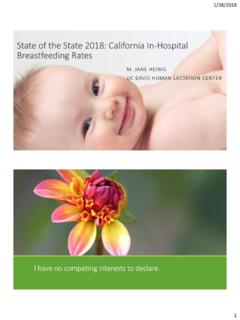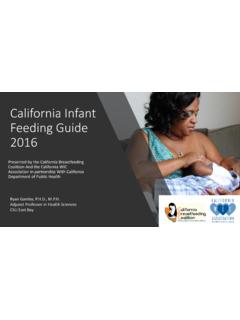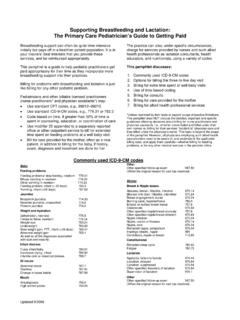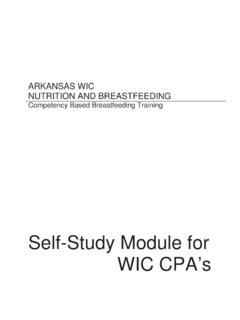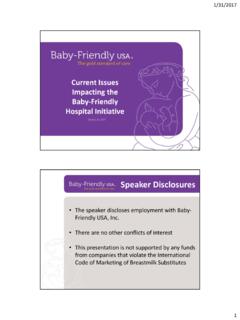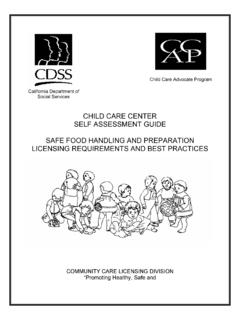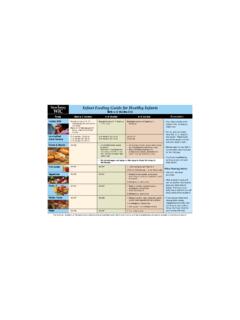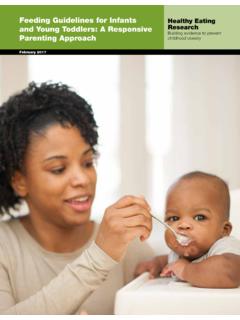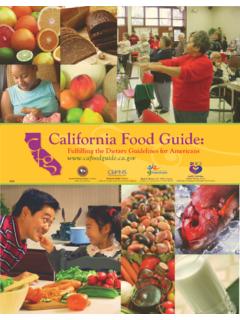Transcription of U.S. Department of Health and Human Services
1 Department of Health and Human Services Katherine R. Shealy, MPH, IBCLC, RLC Ruowei Li, MD, PhD Sandra Benton-Davis, RD, LD Laurence M. Grummer-Strawn, PhD Department OF Health AND Human Services Centers for Disease Control and Prevention National Center for Chronic Disease Prevention and Health Promotion Division of Nutrition and Physical Activity Acknowledgments We gratefully acknowledge and thank all contributors and reviewers of The CDC guide to breastfeeding interventions . The efforts of Jane Heinig, PhD, IBCLC, RLC, Deborah Galuska, PhD, Diana Toomer, Barbara Latham, RD, LD, Carol MacGowan, MPH, RD, LD, Robin Hamre, MPH, RD, and members of the CDC Obesity Team helped make this document possible. Publication Support was provided by Palladian Partners, Inc., under Contract No. 200-980-0415 for the National Center for Chronic Disease Prevention and Health Promotion, Centers for Disease Control and Prevention, Department of Health and Human Services .
2 Photographs contained in this guide were purchased solely for educational purposes and may not be reproduced for commercial use. Recommended Citation Shealy KR, Li R, Benton-Davis S, Grummer-Strawn LM. The CDC guide to breastfeeding interventions . Atlanta: Department of Health and Human Services , Centers for Disease Control and Prevention, 2005. For more information or to download this document or sections of this document, please visit To request additional copies of this document, please email your request to or write to us at the following address and request The CDC guide to breastfeeding interventions : Maternal and Child Nutrition Branch, Division of Nutrition and Physical Activity National Center for Chronic Disease Prevention and Health Promotion Centers for Disease Control and Prevention 4770 Buford Highway, NE Mailstop K 25 Atlanta, Georgia 30341-3717 Contents Introduction Introduction.
3 I Using This guide .. iii Evidence-Based interventions Maternity Care Practices .. 1 Support for breastfeeding in the Workplace .. 7 Peer Support .. 13 Educating Mothers .. 19 Professional Support .. 23 Media and Social Marketing .. 29 interventions Whose Effectiveness Has Not Been Established Countermarketing and the WHO International Code .. 35 Professional Education .. 41 Public Acceptance .. 45 Hotlines and Other Information Resources .. 49 References List of References .. 55 Appendices Expert Panel .. 63 Glossary.. 65 Introduction Using This guide Introduction Introduction Protection, promotion, and support of breastfeeding are critical public Health needs. Healthy People 20101 sets goals for increasing both breastfeeding initiation and duration and decreasing disparities in these rates across all popula-tions in the United States.
4 Increased breastfeeding is also a major program area of the Centers for Disease Control and Prevention s (CDC) State-Based Nutrition and Physical Activity Program to Prevent Obesity and Other Chronic Diseases. Increase the proportion of mothers who 16-19a In the early postpartum period to 75% 16-19b At 6 months to 50% 16-19c At 12 months to 25% Goal 16-19: breastfeed their babies Healthy People 2010 Many types of interventions have been implemented in the United States and elsewhere to try to increase breastfeeding initiation, to increase exclusive breast- feeding , and to increase its duration. Choosing the most appropriate intervention for a given setting and population can be challenging given the breadth of possi-bilities. In an effort to support and assist states in making informed decisions and allocating funds wisely, CDC, with input from external experts in both breastfeed-ing and public Health interventions , compiled this guide .
5 Included in this guide are all the types of breastfeeding interventions that have been reviewed by the Cochrane Collaboration and published through the Cochrane Library, a comprehensive collection of up-to-date information on the effects of Health care interventions . In the 21st century, effective Health care relies not only on individual medical skills but also on the best information on the effectiveness of interventions being accessible to practitioners, patients, and policy makers. This approach is sometimes known as evidence-based medicine. The Cochrane Library is designed to provide information and evidence to support Health care decisions and inform those receiving Because formal evaluation of breastfeeding interventions is not yet widespread, this guide includes some interventions that have not been formally evaluated but Introduction i have an established history or a strong rationale.
6 We Although Human milk banking fulfills unique discuss all major types of interventions known to have medical needs and requires greater support been implemented or thought to promote and support throughout the United States, it is not discussed breastfeeding . in this guide . Banking Human milk is not included because it is not an intervention to promote or support breastfeeding per se. The reader can obtain As readers decide what types of breastfeeding interven-specific guidance on establishing a milk bank from tions to implement locally, they are encouraged through-the Human Milk Banking Association of North out the planning process to incorporate an infrastructure America ( ). to formally evaluate the intervention. Additionally, where possible, they are urged to broadly disseminate their findings, especially in peer-reviewed journals, to help grow the canon of evidence on breastfeeding interventions and in turn assist others in making evidence-based decisions on breastfeeding .
7 Publishing evaluation data is especially important if an intervention is chosen whose effectiveness has not been formally established. In developing this guide , CDC received detailed input and critique from established experts representing the spectrum of breastfeeding in the United States as well as from professionals working within state Health departments within the framework of the CDC State-Based Nutrition and Physical Activity Program to Prevent Obesity and Other Chronic Diseases. The invaluable input from these experts helped focus and refine this guide and thus improve it tremendously. The ch apters of this guide are divided into two categories that are based on evidence for effectiveness. In the first category, the evidence is significant; in the second, it is limited. Readers should note that some interventions have not been shown to be effective standing alone but have been evalu -ated w hen included as components of effective multifaceted interventions .
8 interventions of this type are described as such within the Evidence of Effectiveness section. CDC does not discourage interventions with limited evidence of effectiveness but recommends that if they are used, an evalu -ation o f their effectiveness be carried out before widely disseminating the intervention. This guide is most appropriately used as an introduction to the many interventions that have been developed to protect, promote, and support breastfeeding . As policy makers begin to focus on a particular intervention, they can consult Program Examples, Resources, and the List of References to acquire more in-depth information and to contact others who have implemented the intervention. The CDC guide to breastfeeding interventions ii Using This guide if available. implement it.
9 This document provides guidance and direction in selecting a breastfeeding intervention. It offers the most relevant information on each type of intervention to help the reader make wise decisions. The following categories of information have been included: Definition Briefly describes the intervention, including its target audience and specific goals. Rationale Explains why a particular type of interven-tion is important to breastfeeding . Evidence of Effectiveness Draws on the major peer-reviewed literature to summarize support for the intervention as well as evidence of no effects or of a negative effect. Includes the relevant Cochrane review, Description and Characteristics Highlights characteristics and components of the intervention needed to effectively Program Examples Summarizes high-quality examples of the intervention and describes unique aspects.
10 Examples are provided to show the reader concrete models of various interventions . These examples were selected with expert input from the authors as well as recom-mendations from the Expert Panel. This list is not exhaustive, and other programs with similar characteristics may exist. Resources Guides the reader to further information about programs and other items of interest described earlier in the chapter, such as contact information, Web links, and books. Note: Web site addresses of nonfederal organiza-tions are provided solely as a service to our read-ers. Provision of an address does not constitute an endorsement of this organization by CDC or the federal government, and none should be inferred. CDC is not responsible for the content of the individual organization Web pages. Potential Action Steps Presents a short list of activities that might be undertaken to begin implementing a particular intervention.










